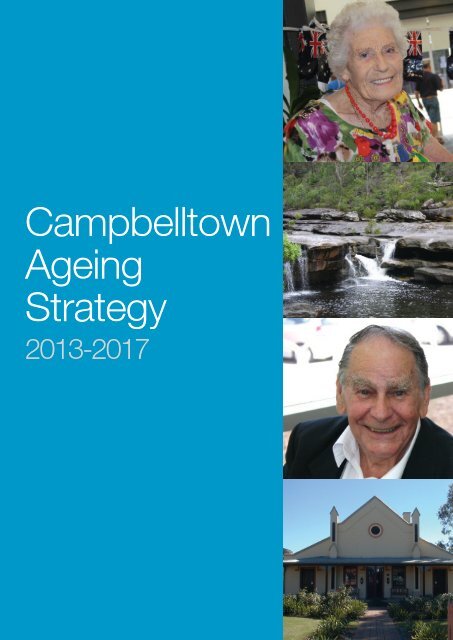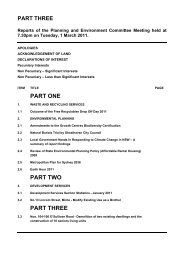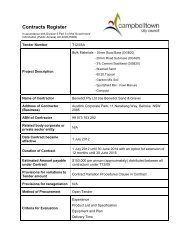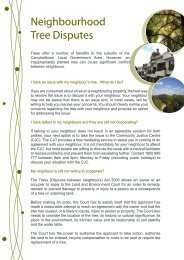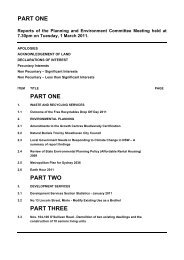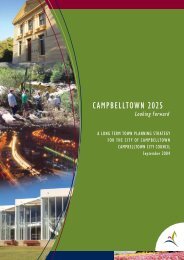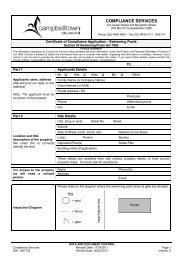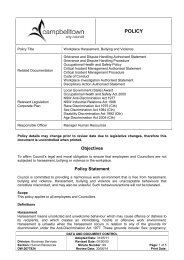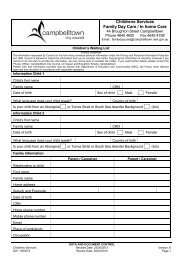Ageing Strategy - Campbelltown City Council - NSW Government
Ageing Strategy - Campbelltown City Council - NSW Government
Ageing Strategy - Campbelltown City Council - NSW Government
You also want an ePaper? Increase the reach of your titles
YUMPU automatically turns print PDFs into web optimized ePapers that Google loves.
<strong>Campbelltown</strong><strong>Ageing</strong><strong>Strategy</strong>2013-20172013-2017
Table of ContentsForeword 1Introduction 2Demographic analysis 3Policy Review 6■ Global context■ National context■ State contextLocal context■<strong>Ageing</strong> in <strong>Campbelltown</strong> 10Current <strong>Council</strong> actions and achievements 12Action Plan 13Reporting and further actionsReferences 18Acronyms and definitionsABSAustralian Bureau of StatisticsDDADisability Discrimination ActDAPDisability Action PlanLGALocal <strong>Government</strong> Area<strong>NSW</strong>New South WalesPAMPPedestrian Access and Mobility PlanCOTA<strong>Council</strong> of the <strong>Ageing</strong>HACCHome and Community CareSEPPState Environmental Planning PolicyDCPDevelopment Control PlanLEPLocal Environmental PlanAgency/serviceCommunityStakeholderany community based, not for profit organisation, group or governmentagency providing advice, resources or services for young people in the<strong>Campbelltown</strong> LGA.the people who live, work or study in the <strong>Campbelltown</strong>Local <strong>Government</strong> Area.a person or group who has an interest or stake in a group.
ForewordThe <strong>Ageing</strong> <strong>Strategy</strong> is a whole of <strong>Council</strong> response to ageing in the cityof <strong>Campbelltown</strong>.The 2010-2012 <strong>Campbelltown</strong> Social Plan identified the need for the strategy.The <strong>Ageing</strong> <strong>Strategy</strong> responds to specific issues identified in the Social Plan, as well as issues identified instate, national, and international documents on ageing.The contributions of older citizens are acknowledged and further opportunities to contribute are identified inthe strategy.This document identifies the location and size of anticipated changes in the population of older people in<strong>Campbelltown</strong>, and promotes positive attitudes to ageing in <strong>Campbelltown</strong>.The strategy also provides a basis for policy and action by government, business andnon-government sectors.MayorCr Sue Dobson1
Introduction<strong>Council</strong>’s Social Plan 2010-2012 identifies 10 key strategies. Of most relevance is the objective to developand implement an <strong>Ageing</strong> <strong>Strategy</strong> to address and respond to the identified priorities.The aims of the <strong>Ageing</strong> <strong>Strategy</strong> are to:■ promote healthy living by supporting community groups and organisations to develop communityhealth and wellbeing initiatives across the region■ reduce social isolation by supporting seniors groups to strengthen their capacity to engage olderpeople■ increase working options for older workers by developing flexible workplace polices■ promote ageing in place by supporting appropriate services to assist older people tostay in their own homes and increase safety awareness.The <strong>Ageing</strong> <strong>Strategy</strong> is designed to be a flexible document that can be changed to respond to the emergingneeds of older people across the city over the next four years. It identifies five key action areas by which anumber of proposed actions will be undertaken by <strong>Council</strong>.2
3 Demographic analysis3.1 Age profileAs of 2011, the <strong>Campbelltown</strong> Local <strong>Government</strong> Area (LGA) was home to 151,221 residents. Of theseresidents, 31,755 persons were aged 55 years and older or 21.04% which is lower than 22.5% acrossGreater Sydney SD. Although relatively small, the population of older people in <strong>Campbelltown</strong> is growingrapidly as large numbers of residents move into retirement.Figure 1 Age profile, 2011Source: ABS Census of Population and Housing (2011)3.2 Indigenous older residents<strong>Campbelltown</strong> is home to one of the largest urban concentrations of Indigenous residents in Australia.As of 2011, there were 4,729 Aboriginal and/or Torres Strait Islanders residing in <strong>Campbelltown</strong> LGA or 1in 11 of all Indigenous residents in Sydney. Of these residents, there were 755 Indigenous residents aged45 years or older, an increase of 47% since 2006.3
3.3 Distribution of older residents in <strong>Campbelltown</strong>The 10 suburbs within the <strong>Campbelltown</strong> LGA with the largest number of residents aged 55+ years arepresented in the following table.Figure 2 Suburb profile, 2011Rank Suburb Population aged 55+ years % of total population 55+1 Ingleburn 3,176 22.82 Macquarie Fields 2,871 20.53 <strong>Campbelltown</strong> 2,697 25.94 Bradbury 2,325 26.65 Leumeah 2,398 25.36 Minto 1,993 19.37 Glenfield 1,940 25.48 Ruse 1,515 27.59 Ambarvale 1,387 18.6/Englorie Park10 St Andrews 1,353 19.0/Bow BowingTOTAL <strong>Campbelltown</strong> LGA 31,755 21.43.4 Cultural and Linguistic DiversityAs of 2011, approximately 51% of residents aged 55 + years were born in Australia, compared with 66%for the overall population of <strong>Campbelltown</strong>. The table below details the top 10 countries of birth of theseresidents.Figure 3 Top 10 country of birth of residents aged 55+ yearsRank Country of birth Total number1 England 25602 Philippines 7603 Scotland 5764 New Zealand 4755 India 4296 Fiji 4177 Germany 3908 Italy 3809 Chile 36610 South Africa 321Source: ABS Census of Population and Housing (2011)3.5 Dwelling typeAs of 2011, 83.3% of individuals aged 55+ years residing in <strong>Campbelltown</strong> LGA lived in a detachedhome, with 12.9% living in either semi-detached, terrace houses or villa units. A very small number – lessthan two% – were residing in high density accommodation. In comparison, there were significantly fewerresidents residing in Greater Sydney SD who lived in separate houses (67.5%), and more who lived in bothsemi-detached, terrace or townhouses (16%), and three or more story unit blocks (10.8%).4
The continued growth in public housing for seniors and the greater availability of smaller dwellings withinthe <strong>Campbelltown</strong> CBD since 2006, supports this data.Figure 4 Dwelling type of residents aged 55+ yearsSource: ABS Census of Population and Housing (2011)3.6 <strong>Ageing</strong> ProjectionsThe population column graph shown in Figure 5 below shows that the projected population growth ofpeople in <strong>Campbelltown</strong> aged 55+ is expected to be much higher than the growth of other age groups in<strong>Campbelltown</strong> between 2011 and 2031.It is anticipated that the geographic distribution of older people in <strong>Campbelltown</strong> will not change greatlyover the next 10 years, with Ingleburn and <strong>Campbelltown</strong> offering the greatest opportunities for housingolder residents.Figure 5 Population projections by five year age cohort, 2011-2031Source: ABS Census of Population and Housing (2011)35
4 Policy Review4.1 Global contextUnited Nations Principles for Older PersonsUnited Nations Principles for Older Persons was adoptedby the General Assembly to appreciate the contribution thatolder persons make to their societies. The policy recognisesthat in a world characterised by an increasing number andproportion of older persons, opportunities must be providedfor willing and capable older persons to participate in andcontribute to the ongoing activities of society. The followingelements are required for older persons to maintain optimumhealth and wellbeing:Independence - older persons should be able to live in environments that are safe and adaptable to personalpreferences and changing capacities, and should be able to reside at home for as long as possible.Participation - older persons should remain integrated in society, and should be able to seek and developopportunities for service to the community and to serve as volunteers in positions appropriate to theirinterests and capabilities.Care - older persons should benefit from family and community care and protection and should be ableto utilise appropriate levels of institutional care providing protection, rehabilitation and social and mentalstimulation in a humane and secure environment.Self-fulfilment - older persons should be able to pursue opportunities for the full development of theirpotential and have access to the educational, cultural, spiritual and recreational resources of society.Dignity – older persons should be free of exploitation and physical or mental abuse, and valued independentlyof their economic contribution.4.2 National contextDepartment of Health and <strong>Ageing</strong> Corporate Plan 2010-2013Top priorities for 2010-2013 include:■ Aged care and population ageing■ Access to quality and affordable aged care and carer support services for older people, includingthrough subsidies and grants, industry assistance, training and regulation of the aged care sector.■ Hearing servicesReduced incidence and consequence of hearing loss.■ Acute careBetter access to public hospitals, acute care services and public dental services.■6
Closing the Gap for Indigenous AustraliansThe Australian <strong>Government</strong>, together with the states and territories through the <strong>Council</strong> of Australian<strong>Government</strong>s, has set specific and ambitious targets to address Indigenous disadvantage. The six keytargets that form the Closing the Gap objective include plans to end the 17 year life expectancy gap withthat of non-Indigenous Australians within a generation. A National Partnership Agreement on Closing theGap in Indigenous Health Outcomes has been developed to address Indigenous disadvantage.Australian Local <strong>Government</strong> Population <strong>Ageing</strong> Action Plan 2004-2008The purpose of the Action Plan is to build the capacity of local government to plan for an ageing population.To achieve this objective, the plan provides a flexible and dynamic framework that builds awareness,encourages action, fosters partnerships and improves access to information.The Action Plan complements other related national ageing strategies, such as the Australian <strong>Government</strong>National <strong>Strategy</strong> for an <strong>Ageing</strong> Australia and intersects with the considerable work already undertaken inindividual jurisdictions.4.3 <strong>NSW</strong> context<strong>NSW</strong> 2021The State Plan is a long term plan to deliver services to the people of <strong>NSW</strong>. It sets targets for better servicedelivery across the public sector in <strong>NSW</strong>. The priorities in the State Plan are a result of consultation with thecommunity, business and stakeholder groups.Goal 25 in the plan states the increased opportunity for seniors in <strong>NSW</strong> to fully participate in communitylife by:■■■the <strong>NSW</strong> <strong>Government</strong> developing a strategy to respond to the implications of population ageingprovide assistance and leadership to build evidence based policy and high quality diverse servicesfor older people across <strong>NSW</strong>encourage flexible working arrangements for older workers and training for those who need toupdate skills or reskill as a result of retrenchment or decision to move to different employment orvolunteering.Towards 2030In April 2008, the <strong>NSW</strong> <strong>Government</strong> released Towards 2030: Planning for our changing population, a wholeof government strategy designed to prepare for demographic change.Towards 2030 incorporates many of the priorities identified in the <strong>NSW</strong> State Plan, but over a longer timeperiod to 2030, and covers five strategic outcomes:■■■■■getting in early and planning for changeimproving prevention and early interventiona productive, skilled and adaptable workforcefacilitating participation in all areas of societyproviding quality care and support.7
<strong>NSW</strong> <strong>Ageing</strong> <strong>Strategy</strong>The <strong>NSW</strong> <strong>Ageing</strong> <strong>Strategy</strong>, released in July 2012, outlines a whole-of-government and whole-of-communitystrategy to help individuals take responsibility for their futures, and to help government departments torecognise and remove any barriers to continued participation by ageing members of the community.Actions highlighted in the strategy include:■■■■additional investment in the <strong>NSW</strong> Community Transport Programdeveloping strategies to implement wellness, capacity-building and restorative careapproaches in <strong>NSW</strong> <strong>Government</strong> community care service providersremoving barriers to workplace participation of mature aged workersimproving housing affordability and accessibility.Division of Local <strong>Government</strong>The Australian Local <strong>Government</strong> Association has pointedout that local government can lead by example in promotingthe positives of an ageing workforce. This may assistcouncils to address skills shortages.Planning for an ageing population can mean that the needsof other groups in the community are also met. Thereforeit does not necessarily mean extra work for councils. Forexample, designing the built environment so that it catersfor older people often means that it also caters for othergroups in the community that experience difficulty withphysical access, such as people with a disability and children.State Environmental Planning Policy (Housing for Seniors or Persons with a Disability) 2004The SEPP 5 aims to encourage the provision of housing (including residential care facilities) that will:■■■increase the supply and diversity of residences that meet the needs of seniorsor people with a disabilitymake efficient use of existing infrastructure and servicesbe of good design.4.4 Local contextIntegrated Planning and Reporting<strong>Council</strong>’s Community Strategic Plan was implemented in July 2012 requiring <strong>Council</strong> to work towards anintegrated planning process where all strategies are linked. The <strong>Ageing</strong> <strong>Strategy</strong> will link to the new <strong>Council</strong>plans, processes and documents.The 10 year Community Strategic Plan consists of a more detailed four-year Delivery Program and anannual Operational Plan.The <strong>Ageing</strong> <strong>Strategy</strong> is aligned with Objective Four – ‘A safe, healthy and connected community’ of the<strong>Campbelltown</strong> Community Strategic Plan.8
The <strong>Ageing</strong> <strong>Strategy</strong> will support the outcomes of the strategies:4.1 The provision of a balanced range of services to the community4.3 The provision of activities that foster a sense of community spirit.Social Plan 2010-2012<strong>Council</strong>’s Social Plan 2010-2012 identified 10 key strategies. Of most relevance was the objective todevelop and implement an <strong>Ageing</strong> <strong>Strategy</strong> to address and respond to the impacts of an ageing communityacross <strong>Council</strong>’s functions and services to the <strong>Campbelltown</strong> community.The Social Plan found that when compared with other areas, <strong>Campbelltown</strong> LGA is ageing more rapidlydue to the large number of baby boomers who moved to the area in the 1970s and 1980s. Between 1986and 2006, there was an increase of 222% for aged people 55+ years residing in <strong>Campbelltown</strong>, comparedto an increase of 23% across Australia. This greying of the population requires suitable housing, as wellas a review of services and facilities focussed on recreation, social, health and support needs (ie footpathmaintenance for people with decreasing mobility).The Social Plan also found that there is a need for:■■■■■improving, increasing and promoting healthy lifestylesaddressing isolation and lonelinesspreparing for an ageing workforceincreasing rate income to offset reduced rate revenue from pensioner rebatesresourcing seniors’ groups to act and lobby on behalf of aged residents residing in the<strong>Campbelltown</strong> LGA.Disability Action Plan 2009-2014The <strong>Campbelltown</strong> Disability Action Plan (DAP) has been developed in response to the DisabilityDiscrimination Act 1992. It commits <strong>Council</strong> to a range of actions that ensure <strong>Council</strong>’s commitment toimproving community access to its services, facilities, information and business processes. Strategiesincluded in the DAP identify the need to improve access to <strong>Council</strong> facilities and ensure communityconsultation and planning processes are accessible and inclusive.9
5 <strong>Ageing</strong> in <strong>Campbelltown</strong>Between 2009-2012, <strong>Council</strong> undertook a number ofconsultations with older residents across <strong>Campbelltown</strong>using a number of techniques. Overall, more than 120older residents were consulted. Consultations were alsoundertaken with managers of each section of <strong>Council</strong> oncurrent and future issues and benefits associated with ourolder residents.<strong>Ageing</strong> workforcePopulation ageing has many implications for the workforce. This may lead to shortages of skilled andexperienced labour as the baby boomer generation retires from the workforce or reduces working hours.The need for on-going engagement of skilled mature aged workers will increase as the supply of youngerworkers declines and the population ages.<strong>Council</strong>’s statistics show that our workforce reflects the current trend with regards to an ageing population– some sections of <strong>Council</strong> will have up to 40% of staff retiring within the next five years. This posesparticular risks to <strong>Council</strong> in addition to the increased competition for talent – the risk of injury in the olderdemographic is higher, potentially impacting on insurance costs and service delivery, and the impendingretirement of a large section of our workforce means a loss of corporate knowledge and experience.<strong>Council</strong> has a four year Workforce Management Plan with a focus on flexibility with employment, knowledgeretention strategies and promotion as an employer of older persons.Community Services<strong>Council</strong>’s Community Services provide a wide range of services to older people, including:■■■■Macarthur Community Options – provision of case management for frail agedCommunity Resources and Development – information and referral, events and group support<strong>Campbelltown</strong> Arts Centre – events and arts projectsLibraries – talking books, large print for popular books, home library and aged care services for thefrail aged and volunteers.Facilities<strong>Council</strong> supports multi-purpose usage of community facilities in order to meet the needs of our diversecommunity. As our city grows and the population ages, there will be increasing demands on <strong>Council</strong>facilities. To meet these increasing and changing demands, buildings will need to be modified and/or newfacilities designed to meet such demands. This includes libraries providing comfortable spaces for peopleto socialise, with a natural evolution towards increasing social programs.As our population changes, <strong>Council</strong> may need to review usage of current facilities to ensure it continues tomeet the needs of the community.10
PlanningAs our population ages, the need increases for a greaterrange of housing types with more diversity closer to services,to support ageing in place. The built environment needs tobe accessible with continuous paths of travel, promotingeasy access to and from public transport, services and socialactivities. Attractive and user friendly streetscapes and openspaces promote walking, and this is known to have healthbenefits and reduce social isolation for older people.With our <strong>City</strong>’s population ageing, demands on <strong>Council</strong> will increase with the number of frail aged residentsrequesting individual rubbish and mowing services. This adds to the workload of staff and increases coststo <strong>Council</strong>.Access<strong>Council</strong>’s Disability Action Plan puts in place strategies designed to help eliminate disability discriminationacross all facets of <strong>Council</strong> facilities and services where possible, therefore improving access for olderpeople.The <strong>Council</strong>’s Traffic Committee looks at issues including traffic flow and road crossings and the PedestrianAccess and Mobility Plan (PAMP) program is for upgrading of footpaths and ramps to make the <strong>City</strong>more accessible. With the creation of continuous paths of travel to and from public transport and variouslocations, barriers to access are reduced.Building and maintenance of infrastructure is pivotal to supporting our ageing population as this increasesaccessibility, therefore promoting social inclusion, activities and healthy living.IncomeGrowth in the number of aged citizens will lead to growth in pensioner rebates, resulting in a reductionof rate income, <strong>Council</strong>’s main source of revenue. <strong>Council</strong>’s Long Term Financial Plan has included thisissue for consideration and has established strategies to ensure continued adequate funding of <strong>Council</strong>operations into the future.11
6 Current <strong>Council</strong> actions and achievementsKey Focus Area 1: Promote healthy living■■■■■■■Support of the Elders Olympics supporting older Aboriginal residents to participate in exercise.Resourcing of <strong>Campbelltown</strong> Seniors Issues Group, consisting of representatives from individualsenior groups across the LGA.Support and resourcing of local Mens Sheds to improve the health and wellbeing of older men.Support and resourcing of Elders on the Go, an Aboriginal health and wellbeing project.Provision of Positive <strong>Ageing</strong> Talks and training for local senior peer presenters in partnershipwith COTA.Healthy Lifestyles – Active Over 50s/gentle exercise/gym/aqua pool classes.Planning and development of outside seniors exercise equipment and cycle ways.Key Focus Area 2: Social support■■■■Planning and delivery of Seniors Week activities.Provision of venues/facilities free of charge or reduced rates including senior citizens club venues.Cemetery bus service transporting local seniors to the Forest Lawn Cemetery each month due tolack of direct public transport from <strong>Campbelltown</strong>.Library services and programs tailored to seniors.Key Focus Area 3: Working and learning■■■Support of U3A and Senior Cyber Seekers.Promotion and support of programs that are tailored towards seniors including Seniors Forums.Planning and development of <strong>Council</strong> Workforce <strong>Strategy</strong>, including flexible working arrangementsfor older workers.Key Focus Area 4: <strong>Ageing</strong> in place■■■<strong>Council</strong> input into planning for services to assist older people to stay in their homes longer.Provision of ‘Wheel Out Wheel Back’ service for frail aged residents.Tender documentation for building and design contracts details access and compliance with DDA.Key Focus Area 5: Infrastructure and transport■■■■Development and implementation of DAP.Supply of community buses to senior groups at reduced rates.PAMP program to improve access on footpaths and ramps.<strong>Council</strong> lobbying for access improvements such as easy access upgrades at railway stations.12
137 ACTION PLANPROMOTE HEALTHY LIVINGSTRATEGY ACTION TIMEFRAME RESPONSIBILITY RESOURCESExternal fundingExisting staff resources<strong>Council</strong> -Recreation ServicesCommunity Resourcesand Development1 year■ Identify affordable healthy foodoptions and promote accordingly■ Promote local area market runsIncreaseopportunities toaccess healthyaffordable foodoptionsExternal fundingExisting staff resources<strong>Council</strong> -Community Resourcesand Developmentongoing■ Facilitation of health and wellbeingpresentationsIncrease awarenessof healthy living■ Support community groups andorganisations to developcommunity health and wellbeinginitiativesExisting staff resources<strong>Council</strong> -Community Resources andDevelopmentRecreation Servicesongoing■ Promotion and delivery of the<strong>NSW</strong> Health programIncrease awarenessand usage of <strong>NSW</strong>Health ProgramExternal fundingExisting staff resources<strong>Council</strong> -Community Resourcesand Development1-2 years■ Run workshops on maintainingindependence, quality of life andcontrol over life decisionsActive and positiveageing■ Advocate and promote access tohealth and social services<strong>Council</strong> -Community Resourcesand DevelopmentRecreation Servicesongoing■ Promote free/low-cost andaccessible exercise opportunitiesIncrease accessto recreationprograms
7 ACTION PLAN - CONTINUEDSOCIAL SUPPORTSTRATEGY ACTION TIMEFRAME RESPONSIBILITY RESOURCESExternal fundingExisting staff resources<strong>Council</strong> –Community Resources andDevelopment2 years■ Development of programs to reachisolated older peopleReduction of socialisolation■ Support provided to seniors groupsto strengthen their capacity toengage older people■ Support older people to maintainlinks to the communityExisting staff resources<strong>Council</strong> -Community Resources andDevelopment,Arts Centre,Communications andMarketing1 year■ Encourage volunteeringIncrease volunteering■ Develop volunteering opportunities■ Volunteering promoted through localmedia■ Development of intergenerationalprograms■ Gift of Time AwardsExisting staff resources<strong>Council</strong> –Community Resources andDevelopment1 year■ Facilitate community forums onseniors issues/topicsEncourageindependenceExisting staff resources<strong>Council</strong> –Community Resources andDevelopmentCommunications andMarketingongoing■ Promote and provide equity andaccess to all <strong>Council</strong>’s activities,programs, facilities andservicesIncrease access toservices■ Develop and/or promote culturallyappropriate services andinformation for CALD/ATSIcommunities14
157 ACTION PLAN - CONTINUEDWORKING AND LEARNINGSTRATEGY ACTION TIMEFRAME RESPONSIBILITY RESOURCESExisting staff resources<strong>Council</strong> -Human Resources1 year■ Promote the benefits of flexibleworkplaces and participation in theworkforce by older workersIncrease workingoptions for olderworkers■ Develop flexible workplace policiesto attract and retain older workersExisting staff resources<strong>Council</strong> –Community Resources andDevelopment,LibrariesArts Centreongoing■ TAFE, universities and independenttraining providers to provide trainingopportunities for older peoplePromotion of lifelonglearning■ Identify appropriate learning/trainingopportunities and promote toseniorsExisting staff resources<strong>Council</strong> -Community Resources andDevelopmentLibraries1 year■ Support Cyber Seekers – jointprogramsIncrease seniorsaccess to technology■ Link with schools for students toteach seniors to use mobile phones■ Promote inter-generational learningand activitiesExisting staff resources<strong>Council</strong> –Community Resources andDevelopment1 year■ Convene special forums/workshops to discuss specificissues as necessary.Awareness raisingof issues for olderpeople
7 ACTION PLAN - CONTINUEDAGEING IN PLACESTRATEGY ACTION TIMEFRAME RESPONSIBILITY RESOURCESExisting staffresources<strong>Council</strong> -Sustainable <strong>City</strong>and Environment3-4 years■ Investigate options for the inclusionof incentives in the DCP toencourage affordable housingIncrease availability ofsuitable housing■ Include incentives in LEP by zoningparticular areas■ Promote flexible and appropriatehousing that can be adapted asneeds and circumstances changeExisting staffresources<strong>Council</strong> -Community Resources andDevelopmentongoing■ Provide information on in-homecare services to maximiseindependence and lifestyle choicesPromote appropriateservices to assist olderpeople to stay in theirown homesExternal fyndingExisting staffresources<strong>Council</strong> -Community Resources andDevelopmentTechnical Services3 years■ Safety audits undertaken in localareas with high density of olderpeopleSafety awareness■ Delivery of safety awarenesssessions to seniorsExternal fundingExisting staffresources<strong>Council</strong> -Community Resources andDevelopmentArts Centre2 years■ Community development programsto increase social connections forolder residentsIncrease sense ofcommunityExisting staffresources<strong>Council</strong> -Community Resources andDevelopmentongoing■ Distribute HACC/Aged andDisability PackProvide appropriateinformation to assistresidents ageing inplace16
177 ACTION PLAN - CONTINUEDINFRASTRUCTURE AND TRANSPORTSTRATEGY ACTION TIMEFRAME RESPONSIBILITY RESOURCESExisting staff resources<strong>Council</strong> -Community Resources andDevelopmentTechnical Servicesongoing■ Implement actions in the DisabilityAction PlanIncrease accessibilitywithin the community■ Implement the PAMP program■ Issues raised at the TrafficCommittee are addressedExisting staff resourcesTo be considered duringdesign and budgetallocation process<strong>Council</strong> -Technical ServicesSustainable <strong>City</strong> andEnvironment3 years■ Increase safety through urbandesign■ Increase continuous path of travelImprovement ofstreetscape in areasof high activity forseniors■ More seating in high pedestriantraffic areasExisting staff resources<strong>Council</strong> -Technical ServicesSustainable <strong>City</strong> andEnvironment2 years■ Improved lighting and signage■ Public transport issues identifiedIncrease availabilityof public transport■ Advocacy on transport issues
8 Reporting and further actionsThe <strong>Ageing</strong> <strong>Strategy</strong> is designed to be a flexible document that can respondto emerging needs over the next five years. In order to ensure that thestrategy is responsive to changes in the community, it will need to beevaluated to measure progress against the strategies under each key focusarea listed in the Action Plan.The review will incorporate, but not be limited, by the following guidelines:■■through consultation with internal and externalstakeholders, amend the <strong>Ageing</strong> <strong>Strategy</strong> to reflect changingconditionsreport progress and changes to <strong>Council</strong> annually through the Integrated Planningand Reporting process.9 ReferencesAustralian Bureau of Statisticswww.abs.gov.auUnited Nationswww.home.vicnet.net.au/~ac99vic/principles.htmlDepartment of Health and <strong>Ageing</strong>www.health.gov.au/internet/main/publishing.nsf/Content/corporate-plan-2010-13Closing the Gaphttp://www.fahcsia.gov.au/our-responsibilities/indigenous-australians/programs-services/closing-the-gapAustralian Local <strong>Government</strong>www.redland.qld.gov.au/SiteCollectionDocuments/Plans_Reports/Studies_Reports/Regional_Qld_Studies/ALGA_<strong>Ageing</strong>_Action_Plan.pdf<strong>NSW</strong> <strong>Government</strong>www.2021.nsw.gov.au/sites/default/files/<strong>NSW</strong>2021_WEBVERSION.pdfwww.adhc.nsw.gov.au/__data/assets/file/0011/257276/1282_ADHC_<strong>NSW</strong>-<strong>Ageing</strong><strong>Strategy</strong>_WEB.pdfwww.dlg.nsw.gov.au/dlg/dlghome/dlg_index.aspwww.planning.nsw.gov.au/housing-for-seniors-and-people-with-disabilities18


